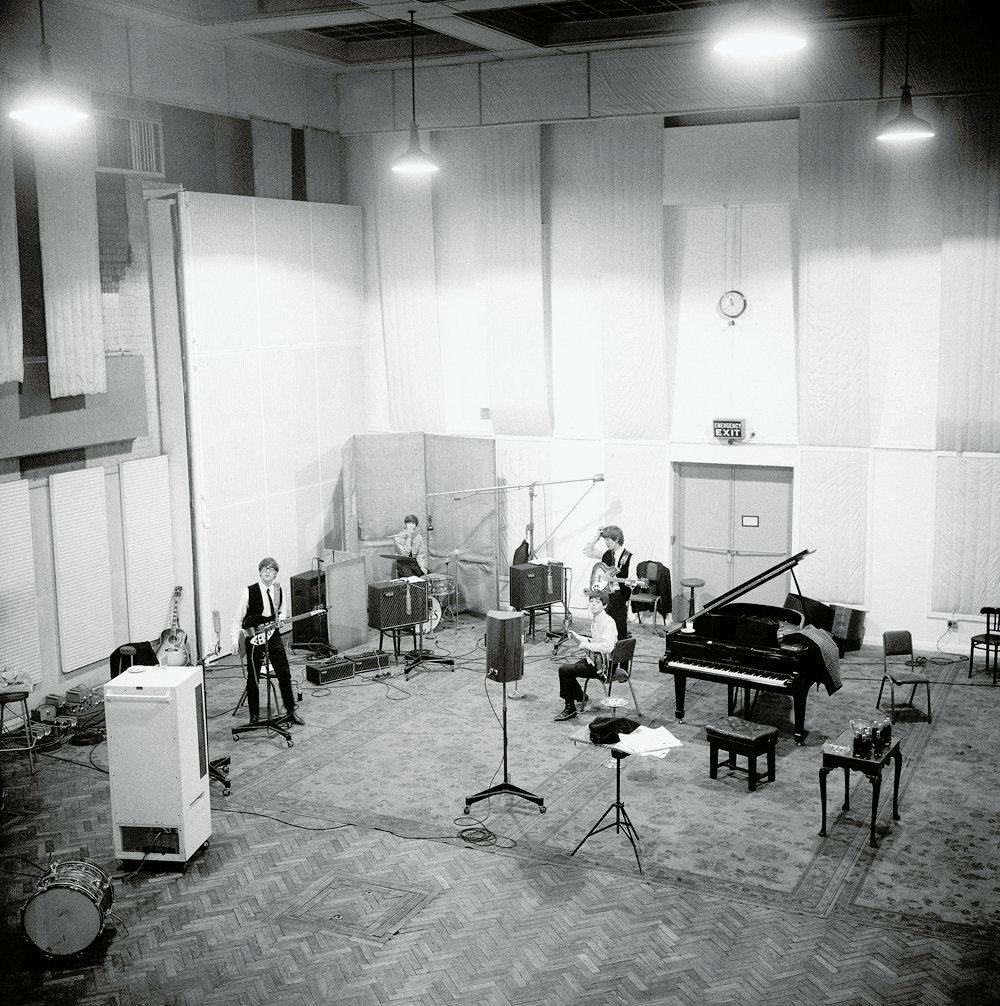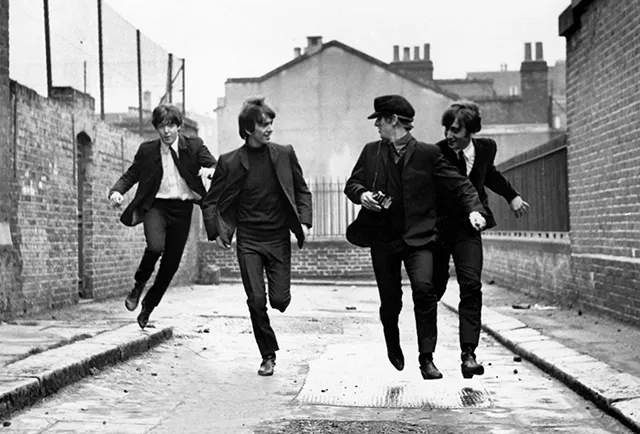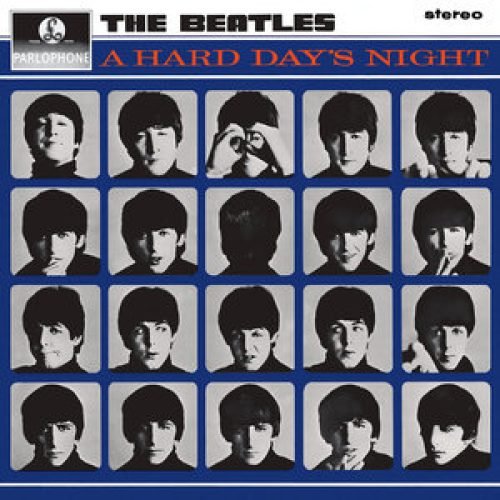“A Hard Day’s Night,” the third studio album by The Beatles, marks a significant milestone not only in the band’s discography but also in the landscape of 1960s pop and rock music. Released in July 1964, at the height of Beatlemania, this album captures the exuberance and youthful vibrancy that defined the era. Unlike its predecessors, “Please Please Me” and “With The Beatles,” which were a mix of original songs and cover tracks, “A Hard Day’s Night” was groundbreaking for featuring entirely original compositions by John Lennon and Paul McCartney. This shift signifies a deepening of The Beatles’ artistic vision, as they began to take more control over their musical narrative and explore the possibilities within their songwriting partnership.
The album, serving as a soundtrack to the band’s eponymous film, was a significant departure from their previous work, showcasing not just their growth as musicians but also their willingness to experiment and push the boundaries of what was expected from pop music at the time. The Beatles’ artistic intentions with “A Hard Day’s Night” were manifold. They aimed to capture the frenetic pace of their lives as touring musicians and global celebrities, as evident in the album’s title track, which opens with a distinctive, ringing chord that heralds the dawn of a new era in rock music. This album was also an attempt to solidify their position as serious artists capable of crafting an entire body of work that was both commercially successful and artistically fulfilling.
Artistic Intentions

From the jangly optimism of “Can’t Buy Me Love” to the melancholic introspection of “Things We Said Today,” “A Hard Day’s Night” delves into themes of love, longing, and the complexities of fame. It’s a vibrant snapshot of The Beatles at a pivotal moment in their career, standing on the cusp between their early pop successes and the more experimental, studio-driven work that would define their later albums. In creating “A Hard Day’s Night,” The Beatles not only deepened existing themes of love and youth but also began to explore new sounds, including the prominent use of electric twelve-string guitar by George Harrison, which would come to influence the folk rock movement.
The Beatles’ artistic vision for “A Hard Day’s Night” was to create an album that was cohesive, dynamic, and reflective of their experiences, both personal and as a band. In doing so, they not only defined the soundtrack of the swinging sixties but also set new standards for what could be achieved in popular music. Through “A Hard Day’s Night,” The Beatles affirmed their roles as pioneers, weaving their musical talents with their artistic ambitions to create an album that remains a timeless classic.
Sonic Exploration

“A Hard Day’s Night” is not just a testament to The Beatles’ songwriting genius but also a showcase of the innovative production and sonic experimentation that would become a hallmark of their career. The production, overseen by George Martin, known as the “Fifth Beatle” for his profound influence on their sound, is notably crisp and vibrant. Martin’s ability to capture the clarity of each instrument, while ensuring that the vocals remain front and center, is a key element of the album’s timeless appeal. The production style serves the album’s themes of youth, love, and the frenetic pace of life in the spotlight by presenting a sound that is both exuberant and meticulously crafted. Each track is polished, yet retains an energy that feels live and immediate, a balance that few albums of the era managed to achieve.
Musical Arrangements
The musical arrangements on “A Hard Day’s Night” are both innovative and memorable, particularly for the time. The album opens with that famously complex chord, a sonic burst that immediately captures the listener’s attention. The use of the 12-string electric guitar by George Harrison, especially on the title track, was revolutionary, giving the album a jangly, bright sound that would influence countless bands in the mid-60s, notably the Byrds and the folk rock movement. The harmonies of Lennon, McCartney, and Harrison are tighter and more adventurous than on previous albums, with tracks like “If I Fell” showcasing their ability to blend their voices in intricate, yet effortlessly melodic ways. The rhythm section, too, deserves mention; Ringo Starr’s drumming is both supportive and dynamic, providing a solid foundation that allows the songs to soar.
Genre Elements
In terms of genre, “A Hard Day’s Night” firmly roots itself in the pop and rock traditions, yet it is far from a straightforward album. While it stays true to the rock and roll ethos, the album also dabbles in the edges of folk music and balladry, prefiguring the more eclectic sonic explorations The Beatles would undertake in later works. Songs like “I Should Have Known Better” with its harmonica intro, and “And I Love Her,” a tender, acoustic love ballad, showcase the band’s ability to blend genres in a way that feels both novel and entirely their own. The Beatles’ embrace of different musical styles, coupled with their innovative use of studio techniques and arrangements, allows the album to transcend simple genre classifications, making it a pioneering work that expanded the possibilities of pop music.
Lyrical Analysis

The lyrical landscape of “A Hard Day’s Night” is a rich tapestry that weaves together themes of love, longing, and the nuances of human relationships, set against the backdrop of The Beatles’ whirlwind rise to fame. The central theme of the album is unmistakably love, a universal subject that The Beatles manage to explore with a refreshing depth and variety. From the euphoric declarations in “Can’t Buy Me Love” to the introspective and nuanced reflections in “Things We Said Today,” the album traverses the emotional spectrum of love and relationships with remarkable dexterity. Recurring motifs of joy, heartache, and the yearning for connection permeate the album, providing a cohesive narrative thread that binds the songs together.
The lyrical depth of “A Hard Day’s Night” showcases John Lennon and Paul McCartney’s growing sophistication as songwriters. While many of the lyrics maintain the straightforward, narrative style characteristic of early rock and roll, there are moments of poetic subtlety and complexity that hint at the more abstract, introspective direction their writing would take in later years. Songs like “If I Fell” and “And I Love Her” reveal a vulnerability and emotional honesty that was relatively uncommon in pop music at the time, breaking away from the simpler love songs that dominated the charts. The lyrics of “A Hard Day’s Night” are accessible yet rich with meaning, offering layers of interpretation that invite the listener to delve deeper into the songs’ emotional and thematic undercurrents.
Emotional Impact
The emotional impact of the album is profound, with the lyrics playing a pivotal role in its resonance. The Beatles’ ability to articulate the exhilarating highs and poignant lows of love and fame allows listeners to find pieces of their own experiences reflected in the music. The joyous optimism of “Can’t Buy Me Love” and “A Hard Day’s Night” evokes a sense of liberation and exhilaration, capturing the spirit of youth and freedom. In contrast, tracks like “I’m Happy Just to Dance with You” and “Things We Said Today” offer a more contemplative, bittersweet perspective on love’s fleeting nature, inviting empathy and introspection. The album, through its lyrical exploration, becomes a mirror to the listener’s own feelings, eliciting a wide range of emotional responses from joy and excitement to nostalgia and contemplation.
In “A Hard Day’s Night,” The Beatles demonstrate an extraordinary capacity to connect with listeners on an emotional level, blending catchy melodies with lyrical depth that ranges from the exuberant to the introspective. The album’s lyrical content not only underscores its thematic cohesion and artistic ambitions but also solidifies its emotional impact, ensuring its enduring legacy in the canon of popular music. Through their nuanced and expressive songwriting, The Beatles invite us into a world where love, in all its complexity, is both celebrated and earnestly examined, making “A Hard Day’s Night” a masterpiece of lyrical storytelling.
Cohesion and Flow

The seamless flow and striking cohesion of “A Hard Day’s Night” underscore its status as one of The Beatles’ most unified and conceptually tight albums. From the electrifying opening chord of the title track to the reflective closing notes of “I’ll Be Back,” the album takes listeners on a journey that is both narratively engaging and emotionally resonant. The progression of tracks is masterfully curated to balance the upbeat, high-energy numbers with more introspective, moodier songs, creating a dynamic listening experience that mirrors the ebbs and flows of the themes it explores.
The narrative and emotional progression of the album is subtle yet impactful, beginning with the jubilant declaration of love and independence in “A Hard Day’s Night” and moving through various shades of romantic and personal introspection. The track order smartly places the more upbeat, pop-oriented songs at the forefront, gradually giving way to the deeper, more contemplative tracks as the album unfolds. This creates a sense of growth and depth, both musically and lyrically, as the listener is guided through the complexities of love and life that The Beatles are contemplating at this stage of their career.
Thematic Consistency
Thematic consistency is another area where “A Hard Day’s Night” excels. The album maintains a strong focus on the intricacies of relationships, viewed through the lens of youthful optimism and the occasional shadow of doubt and reflection. Musically, the album stays true to the energetic, melodic pop-rock that had become The Beatles’ trademark, while also introducing elements of folk and balladry that hint at the band’s evolving musical interests. The emotional tone is remarkably consistent, with each track contributing to a larger narrative that feels both personal and universally relatable. Even the more light-hearted songs carry a depth of feeling that reinforces the album’s overarching themes of love, longing, and the passage of time.
While “A Hard Day’s Night” is diverse in its musical and lyrical themes, there are no jarring shifts that disrupt the album’s flow. Instead, The Beatles demonstrate an exceptional ability to explore a variety of styles and emotions while maintaining a cohesive sound and vision. The transitions between tracks are smooth and intuitive, often highlighting the band’s innovative use of musical motifs and lyrical callbacks to weave a tighter narrative thread throughout the album.
Standout Tracks and Moments

“A Hard Day’s Night” is an album replete with musical innovation and emotional depth, with several tracks standing out not just within the context of the album but also within The Beatles’ illustrious career. Among these, the title track, “A Hard Day’s Night,” is immediately recognizable for its opening chord—a bold, dissonant burst of sound that perfectly encapsulates the exhilaration and exhaustion referenced in the song’s lyrics. This track not only sets the tone for the entire album but also marked a significant moment in rock music, showcasing The Beatles’ willingness to experiment with unconventional harmonies and song structures.
“Can’t Buy Me Love” stands out for its sheer exuberance and its representation of the band’s more straightforward rock and roll influences. The song’s infectious energy and memorable chorus made it a commercial success, but it’s the simplicity and purity of its message that endears it to listeners, emphasizing love over material wealth in a manner that’s both sincere and uplifting.
“And I Love Her” is another highlight, showcasing Paul McCartney’s talent for crafting ballads of remarkable beauty and depth. The song’s gentle, Latin-inspired rhythm and the understated, yet expressive guitar work by George Harrison contribute to its timeless appeal. The soft, almost whispered vocals convey a vulnerability that was somewhat uncommon in pop music at the time, making “And I Love Her” a seminal track in The Beatles’ move towards more introspective and complex songwriting.
Memorable Moments
Memorable moments within the album abound, but the solo in “I Should Have Known Better,” played on a harmonica by John Lennon, is particularly evocative, bringing a raw, bluesy feel to the song that contrasts beautifully with its upbeat tempo and joyful lyrics. This moment captures the band’s ability to blend different musical traditions into something uniquely their own.
Another unforgettable moment is the intricate vocal harmony in “If I Fell,” a song that exemplifies the emotional and musical complexity The Beatles were capable of achieving. The vulnerability expressed in the lyrics, combined with the delicate balance of the vocals, creates a moment of profound intimacy, inviting listeners into a more personal and reflective space.
The closing track, “I’ll Be Back,” with its fluctuating major and minor harmonies, offers a fitting end to the album. Its slightly melancholic tone hints at the more experimental directions The Beatles would explore in subsequent albums, showcasing their evolving artistic vision. The song’s recurring refrain, combined with the emotive delivery, leaves a lingering sense of longing and anticipation, a promise of more to come.
In “A Hard Day’s Night,” standout tracks and memorable moments are not just highlights of a single album but pivotal points in the broader narrative of The Beatles’ journey as artists. Each song, each chord, and each lyric serves as a testament to their groundbreaking approach to music-making, blending pop sensibilities with an adventurous spirit that would come to define their legacy.
Artistic Contribution and Innovation

“A Hard Day’s Night” not only solidified The Beatles’ place in the pantheon of pop and rock music but also marked a pivotal moment in the evolution of the music industry itself. Within its genre, the album is seen as a revolutionary work that pushed the boundaries of what was considered possible in pop music. Its release at the height of Beatlemania meant it was perfectly positioned to influence a generation of musicians, producers, and fans, shaping the sound and ethos of the 1960s and beyond.
One of the most innovative aspects of the album is its distinction as the first Beatles album comprised entirely of original compositions. This break from the norm of including cover songs on albums was not just a show of artistic independence and maturity; it set a new standard for pop and rock albums, emphasizing the importance of songwriting and artistic voice within the genre. This move encouraged other bands and artists to pursue greater creativity and originality in their work, contributing to the rich diversity of music that characterized the latter half of the 20th century.
The production of “A Hard Day’s Night,” under the guidance of George Martin, showcased several innovative techniques that would influence the industry for years to come. The use of advanced recording technology and creative studio practices, such as overdubbing and direct input recording for George Harrison’s electric 12-string guitar, enhanced the clarity and depth of the album’s sound. These techniques, though now common, were groundbreaking at the time and contributed significantly to the album’s distinctive sound.
In terms of genre, “A Hard Day’s Night” adheres to the conventions of pop and rock but also ventures into uncharted territory. The Beatles’ foray into different styles, including folk rock and balladry, not only showcases their versatility as musicians but also their ability to blend and transcend genres. This eclectic approach would become a hallmark of their later work and inspire countless other artists to explore and innovate within their musical styles.
Thematically, the album explores familiar topics like love and relationships but with a newfound depth and complexity. This thematic exploration, combined with the album’s musical innovation, reflects The Beatles’ growing awareness of their artistic potential and their desire to use their music as a means of personal and social commentary. The emotional honesty and introspective quality of the lyrics, coupled with the sophistication of the music, set “A Hard Day’s Night” apart from much of the pop music of its time, offering a more nuanced and mature perspective on the human experience.
“A Hard Day’s Night” stands as a testament to The Beatles’ artistic contribution and innovation. It is an album that not only pushed the boundaries of its genre but also challenged and expanded the creative possibilities of the music industry as a whole. Through its original composition, innovative production techniques, genre-blending sound, and thematic depth, “A Hard Day’s Night” exemplifies the transformative power of music and remains a seminal work in the history of popular culture.
Closing Thoughts

“A Hard Day’s Night” stands as a monumental achievement in The Beatles’ illustrious career and the broader landscape of 20th-century music. Its strengths are manifold, beginning with its pioneering all-original tracklist that showcased John Lennon and Paul McCartney’s burgeoning songwriting talents. The album’s production, under the expert guidance of George Martin, set new standards for recording quality and innovation, while the musical arrangements and genre-blending showcased The Beatles’ versatility and willingness to experiment. Thematically, the album explored the complexities of love and fame with a depth and sincerity that was ahead of its time, further solidifying the band’s reputation as artists of substance and vision.
If one were to search for weaknesses, they might point to the album’s consistency and thematic coherence as a double-edged sword, leaving little room for the kind of musical diversification and experimentation that would characterize later Beatles albums. However, this critique barely diminishes the album’s overall impact and might more accurately reflect the band’s developmental trajectory rather than a flaw in the work itself.
Official Rating
Given its significant artistic contributions, innovations, and the sheer quality of its music and lyrics, “A Hard Day’s Night” is deserving of a rating of 9 out of 10. This score reflects both its historical importance and enduring appeal. The album not only captured the zeitgeist of the early 1960s but also laid the groundwork for future musical exploration, influencing generations of artists across genres. Its slight deduction from a perfect score acknowledges the even greater creative heights The Beatles would achieve in subsequent projects, highlighting “A Hard Day’s Night” as a pivotal, though not final, peak in their artistic journey.
